HIEU 164: Exploring Women Missionaries in 17th Century Canada
VerifiedAdded on 2023/07/07
|24
|4784
|99
Essay
AI Summary
This essay explores the experiences of women missionaries in 17th-century Canada, focusing on their motivations, challenges, and contributions. Driven by religious fervor and the Catholic Church's desire to expand its influence, these women aimed to connect with Indigenous populations, particularly women and children, to propagate the Christian faith. The essay highlights Marie de l'Incarnation as a key figure, detailing her efforts to establish the Ursuline Convent and her interactions with Indigenous communities, as documented in the Jesuit Relations. Despite facing gender bias, cultural barriers, language difficulties, social isolation, and harsh living conditions, these missionaries played a crucial role in promoting cross-cultural understanding, education, and the assimilation of Indigenous peoples into European culture. Their resilience and dedication left a lasting impact on Canadian history, paving the way for greater female participation and influence in society.

Jason Baselyos
HIEU 164
Professor Strasser
06/08/2023
Women Missionaries
For women missionaries in Canada, the 17th century was a
revolutionary time. Women's religious organizations dispatched
missionaries to Canada out of a love for religion and a desire to
increase the Catholic Church's power. To propagate the Christian
faith and build trust, these organizations believed that women could
effectively connect with Indigenous populations, especially women
and children. Women missionaries showed tremendous resiliency
and commitment despite encountering challenges such as illness
risk, hostile local cultures, language hurdles, and difficult living
conditions. They developed contacts with Indigenous people,
assimilated into their cultures, and were instrumental in advancing
education and women's emancipation. Their initiatives promoted
cross-cultural understanding, enhanced trade, questioned
conventional gender norms, and laid the groundwork for women's
greater participation and influence in Canadian society. These
women's experiences as missionaries in 17th-century Canada
HIEU 164
Professor Strasser
06/08/2023
Women Missionaries
For women missionaries in Canada, the 17th century was a
revolutionary time. Women's religious organizations dispatched
missionaries to Canada out of a love for religion and a desire to
increase the Catholic Church's power. To propagate the Christian
faith and build trust, these organizations believed that women could
effectively connect with Indigenous populations, especially women
and children. Women missionaries showed tremendous resiliency
and commitment despite encountering challenges such as illness
risk, hostile local cultures, language hurdles, and difficult living
conditions. They developed contacts with Indigenous people,
assimilated into their cultures, and were instrumental in advancing
education and women's emancipation. Their initiatives promoted
cross-cultural understanding, enhanced trade, questioned
conventional gender norms, and laid the groundwork for women's
greater participation and influence in Canadian society. These
women's experiences as missionaries in 17th-century Canada
Paraphrase This Document
Need a fresh take? Get an instant paraphrase of this document with our AI Paraphraser
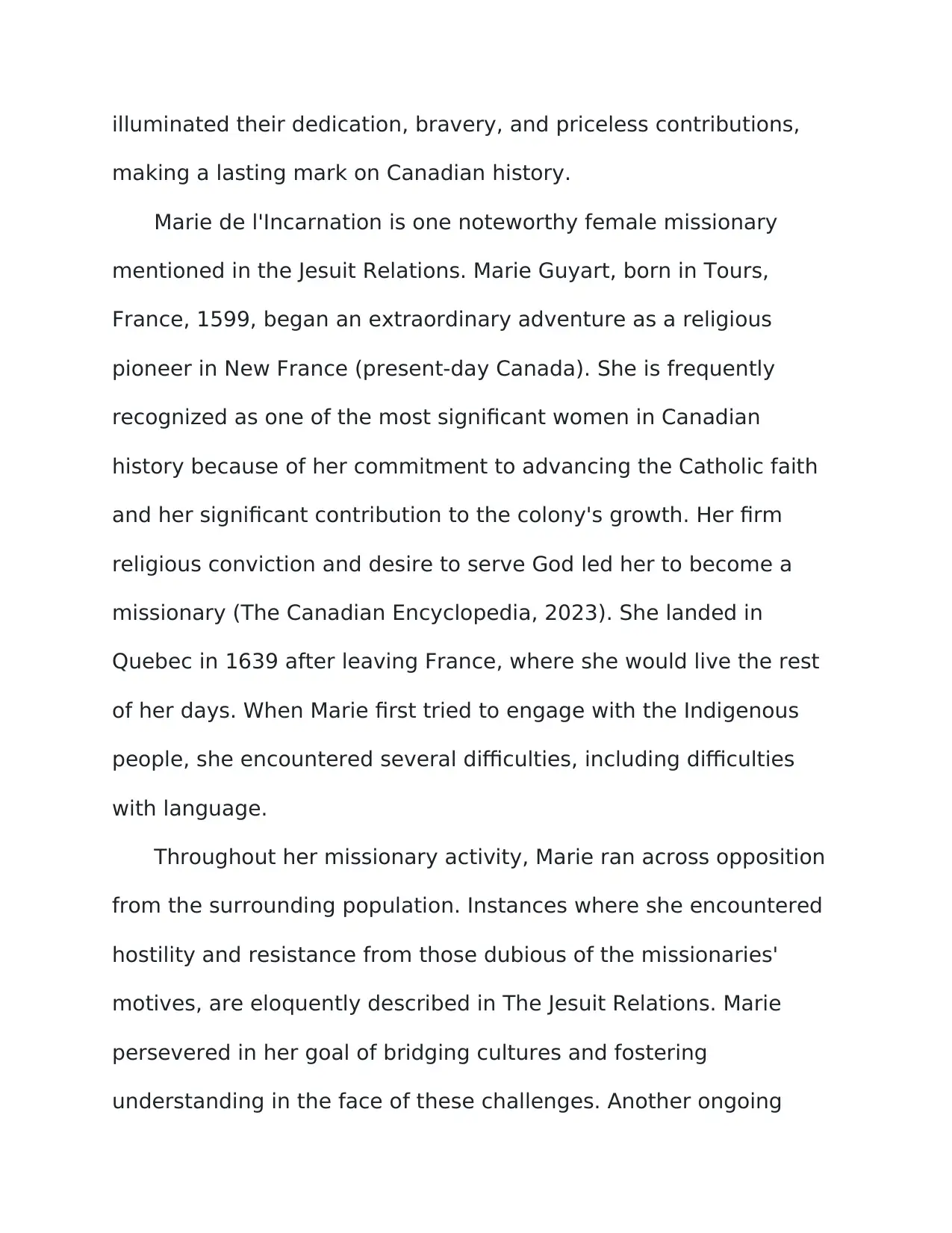
illuminated their dedication, bravery, and priceless contributions,
making a lasting mark on Canadian history.
Marie de l'Incarnation is one noteworthy female missionary
mentioned in the Jesuit Relations. Marie Guyart, born in Tours,
France, 1599, began an extraordinary adventure as a religious
pioneer in New France (present-day Canada). She is frequently
recognized as one of the most significant women in Canadian
history because of her commitment to advancing the Catholic faith
and her significant contribution to the colony's growth. Her firm
religious conviction and desire to serve God led her to become a
missionary (The Canadian Encyclopedia, 2023). She landed in
Quebec in 1639 after leaving France, where she would live the rest
of her days. When Marie first tried to engage with the Indigenous
people, she encountered several difficulties, including difficulties
with language.
Throughout her missionary activity, Marie ran across opposition
from the surrounding population. Instances where she encountered
hostility and resistance from those dubious of the missionaries'
motives, are eloquently described in The Jesuit Relations. Marie
persevered in her goal of bridging cultures and fostering
understanding in the face of these challenges. Another ongoing
making a lasting mark on Canadian history.
Marie de l'Incarnation is one noteworthy female missionary
mentioned in the Jesuit Relations. Marie Guyart, born in Tours,
France, 1599, began an extraordinary adventure as a religious
pioneer in New France (present-day Canada). She is frequently
recognized as one of the most significant women in Canadian
history because of her commitment to advancing the Catholic faith
and her significant contribution to the colony's growth. Her firm
religious conviction and desire to serve God led her to become a
missionary (The Canadian Encyclopedia, 2023). She landed in
Quebec in 1639 after leaving France, where she would live the rest
of her days. When Marie first tried to engage with the Indigenous
people, she encountered several difficulties, including difficulties
with language.
Throughout her missionary activity, Marie ran across opposition
from the surrounding population. Instances where she encountered
hostility and resistance from those dubious of the missionaries'
motives, are eloquently described in The Jesuit Relations. Marie
persevered in her goal of bridging cultures and fostering
understanding in the face of these challenges. Another ongoing
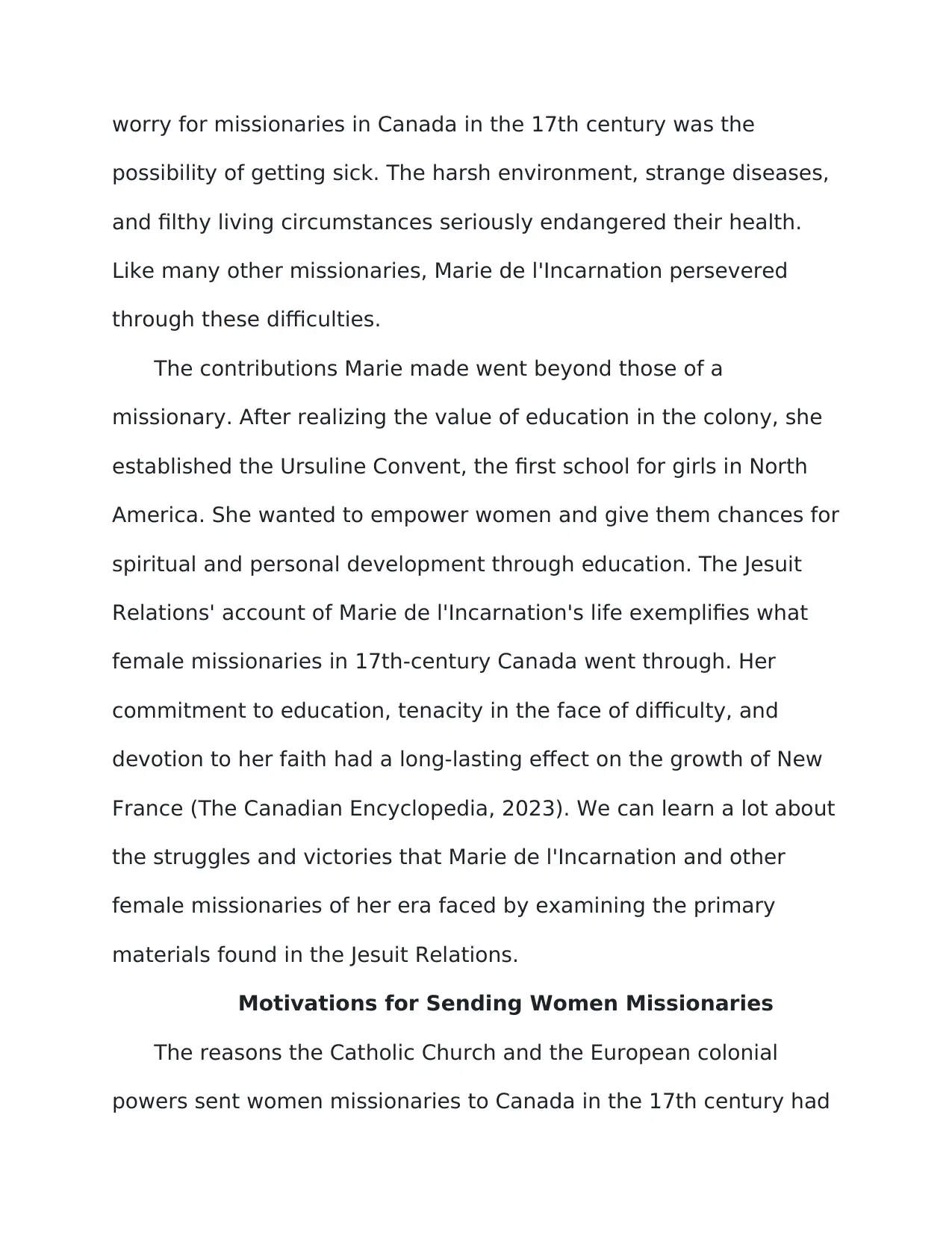
worry for missionaries in Canada in the 17th century was the
possibility of getting sick. The harsh environment, strange diseases,
and filthy living circumstances seriously endangered their health.
Like many other missionaries, Marie de l'Incarnation persevered
through these difficulties.
The contributions Marie made went beyond those of a
missionary. After realizing the value of education in the colony, she
established the Ursuline Convent, the first school for girls in North
America. She wanted to empower women and give them chances for
spiritual and personal development through education. The Jesuit
Relations' account of Marie de l'Incarnation's life exemplifies what
female missionaries in 17th-century Canada went through. Her
commitment to education, tenacity in the face of difficulty, and
devotion to her faith had a long-lasting effect on the growth of New
France (The Canadian Encyclopedia, 2023). We can learn a lot about
the struggles and victories that Marie de l'Incarnation and other
female missionaries of her era faced by examining the primary
materials found in the Jesuit Relations.
Motivations for Sending Women Missionaries
The reasons the Catholic Church and the European colonial
powers sent women missionaries to Canada in the 17th century had
possibility of getting sick. The harsh environment, strange diseases,
and filthy living circumstances seriously endangered their health.
Like many other missionaries, Marie de l'Incarnation persevered
through these difficulties.
The contributions Marie made went beyond those of a
missionary. After realizing the value of education in the colony, she
established the Ursuline Convent, the first school for girls in North
America. She wanted to empower women and give them chances for
spiritual and personal development through education. The Jesuit
Relations' account of Marie de l'Incarnation's life exemplifies what
female missionaries in 17th-century Canada went through. Her
commitment to education, tenacity in the face of difficulty, and
devotion to her faith had a long-lasting effect on the growth of New
France (The Canadian Encyclopedia, 2023). We can learn a lot about
the struggles and victories that Marie de l'Incarnation and other
female missionaries of her era faced by examining the primary
materials found in the Jesuit Relations.
Motivations for Sending Women Missionaries
The reasons the Catholic Church and the European colonial
powers sent women missionaries to Canada in the 17th century had
⊘ This is a preview!⊘
Do you want full access?
Subscribe today to unlock all pages.

Trusted by 1+ million students worldwide

to do with their larger objectives. The Catholic Church tried to
evangelize and extend its influence in new lands, notably among
indigenous populations. For several reasons, women's religious
orders were seen as crucial to this project. Women missionaries
were seen to be particularly adept at relating to women and children
in Indigenous communities (The Canadian Encyclopedia, 2023).
They were regarded as more personable and able to create bonds of
trust and empathy. The missionaries intended to lay a foundation of
faith that would eventually spread to the entire community by
concentrating on women and children. According to women's
religious orders, Indigenous women's conversion would result in the
conversion of their families and communities as a whole.
In addition, European society frequently trusted women to
provide for and educate children, and Indigenous communities
adopted this strategy. Women missionaries were meant to impart
Christian values, European traditions, and valuable skills like reading
and writing to Indigenous women and children. This schooling aimed
to elevate Indigenous peoples and integrate them into European
culture. Furthermore, it was believed that the presence of female
missionaries would promote European values and cross-cultural
understanding (The Canadian Encyclopedia, 2023). In the eyes of
evangelize and extend its influence in new lands, notably among
indigenous populations. For several reasons, women's religious
orders were seen as crucial to this project. Women missionaries
were seen to be particularly adept at relating to women and children
in Indigenous communities (The Canadian Encyclopedia, 2023).
They were regarded as more personable and able to create bonds of
trust and empathy. The missionaries intended to lay a foundation of
faith that would eventually spread to the entire community by
concentrating on women and children. According to women's
religious orders, Indigenous women's conversion would result in the
conversion of their families and communities as a whole.
In addition, European society frequently trusted women to
provide for and educate children, and Indigenous communities
adopted this strategy. Women missionaries were meant to impart
Christian values, European traditions, and valuable skills like reading
and writing to Indigenous women and children. This schooling aimed
to elevate Indigenous peoples and integrate them into European
culture. Furthermore, it was believed that the presence of female
missionaries would promote European values and cross-cultural
understanding (The Canadian Encyclopedia, 2023). In the eyes of
Paraphrase This Document
Need a fresh take? Get an instant paraphrase of this document with our AI Paraphraser
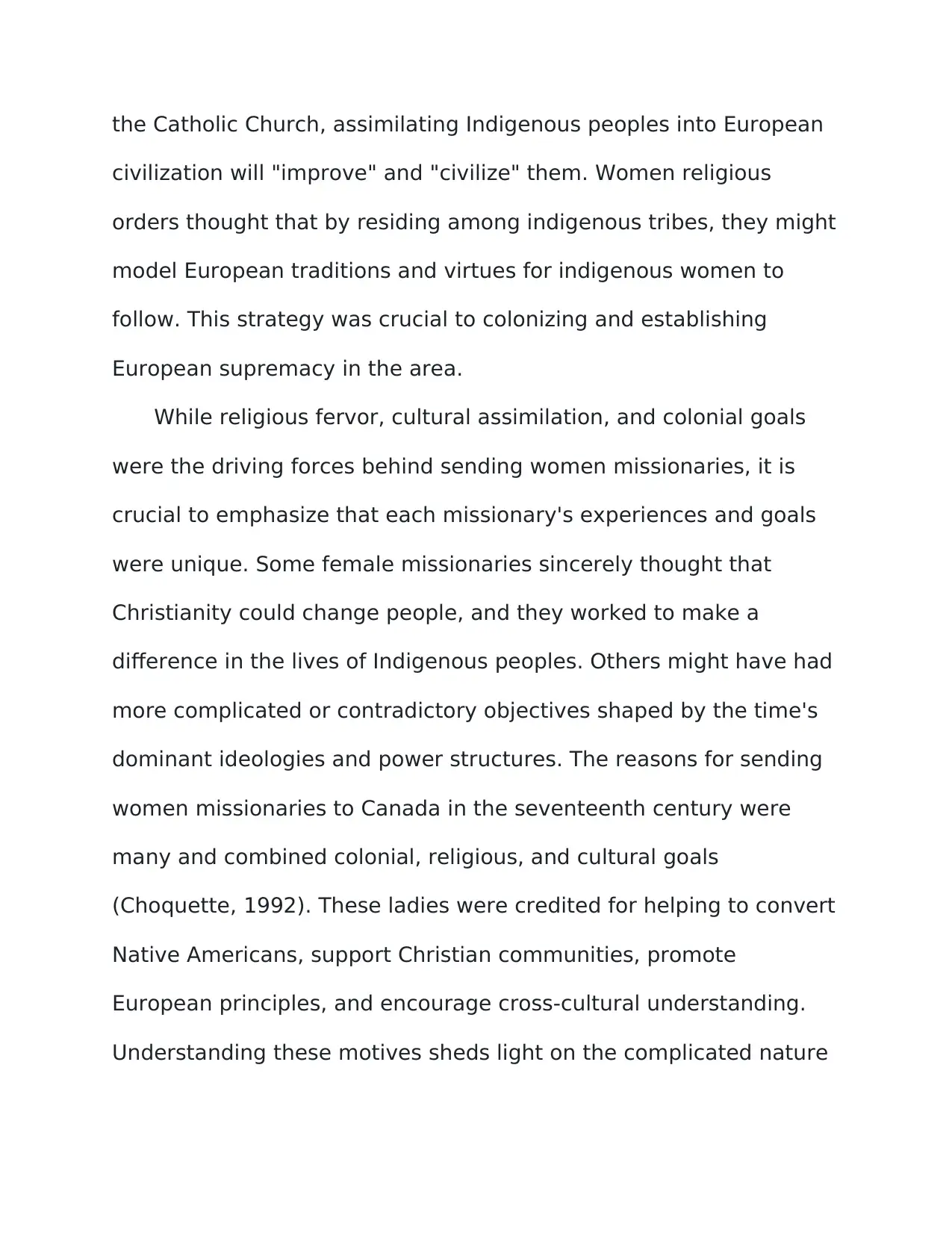
the Catholic Church, assimilating Indigenous peoples into European
civilization will "improve" and "civilize" them. Women religious
orders thought that by residing among indigenous tribes, they might
model European traditions and virtues for indigenous women to
follow. This strategy was crucial to colonizing and establishing
European supremacy in the area.
While religious fervor, cultural assimilation, and colonial goals
were the driving forces behind sending women missionaries, it is
crucial to emphasize that each missionary's experiences and goals
were unique. Some female missionaries sincerely thought that
Christianity could change people, and they worked to make a
difference in the lives of Indigenous peoples. Others might have had
more complicated or contradictory objectives shaped by the time's
dominant ideologies and power structures. The reasons for sending
women missionaries to Canada in the seventeenth century were
many and combined colonial, religious, and cultural goals
(Choquette, 1992). These ladies were credited for helping to convert
Native Americans, support Christian communities, promote
European principles, and encourage cross-cultural understanding.
Understanding these motives sheds light on the complicated nature
civilization will "improve" and "civilize" them. Women religious
orders thought that by residing among indigenous tribes, they might
model European traditions and virtues for indigenous women to
follow. This strategy was crucial to colonizing and establishing
European supremacy in the area.
While religious fervor, cultural assimilation, and colonial goals
were the driving forces behind sending women missionaries, it is
crucial to emphasize that each missionary's experiences and goals
were unique. Some female missionaries sincerely thought that
Christianity could change people, and they worked to make a
difference in the lives of Indigenous peoples. Others might have had
more complicated or contradictory objectives shaped by the time's
dominant ideologies and power structures. The reasons for sending
women missionaries to Canada in the seventeenth century were
many and combined colonial, religious, and cultural goals
(Choquette, 1992). These ladies were credited for helping to convert
Native Americans, support Christian communities, promote
European principles, and encourage cross-cultural understanding.
Understanding these motives sheds light on the complicated nature
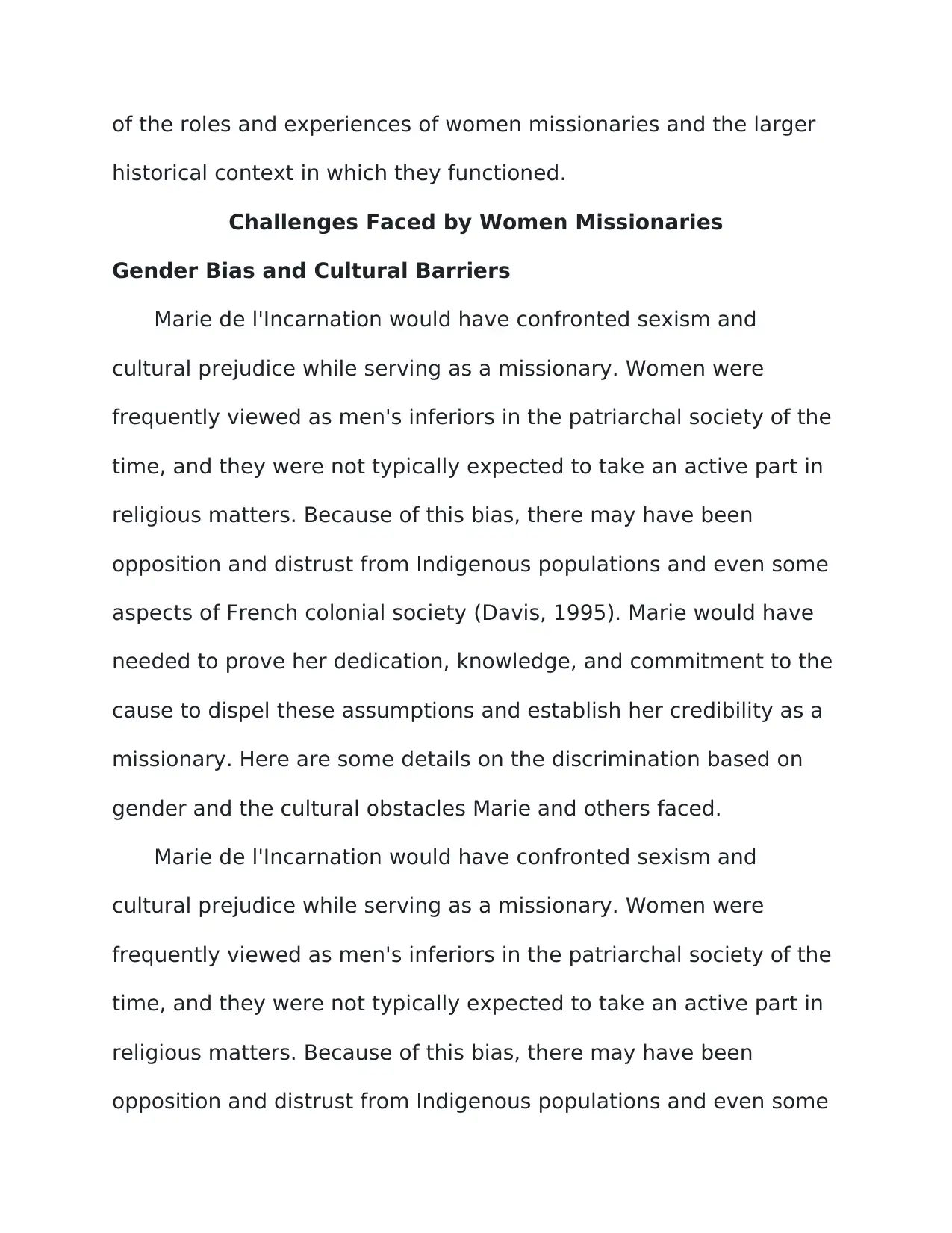
of the roles and experiences of women missionaries and the larger
historical context in which they functioned.
Challenges Faced by Women Missionaries
Gender Bias and Cultural Barriers
Marie de l'Incarnation would have confronted sexism and
cultural prejudice while serving as a missionary. Women were
frequently viewed as men's inferiors in the patriarchal society of the
time, and they were not typically expected to take an active part in
religious matters. Because of this bias, there may have been
opposition and distrust from Indigenous populations and even some
aspects of French colonial society (Davis, 1995). Marie would have
needed to prove her dedication, knowledge, and commitment to the
cause to dispel these assumptions and establish her credibility as a
missionary. Here are some details on the discrimination based on
gender and the cultural obstacles Marie and others faced.
Marie de l'Incarnation would have confronted sexism and
cultural prejudice while serving as a missionary. Women were
frequently viewed as men's inferiors in the patriarchal society of the
time, and they were not typically expected to take an active part in
religious matters. Because of this bias, there may have been
opposition and distrust from Indigenous populations and even some
historical context in which they functioned.
Challenges Faced by Women Missionaries
Gender Bias and Cultural Barriers
Marie de l'Incarnation would have confronted sexism and
cultural prejudice while serving as a missionary. Women were
frequently viewed as men's inferiors in the patriarchal society of the
time, and they were not typically expected to take an active part in
religious matters. Because of this bias, there may have been
opposition and distrust from Indigenous populations and even some
aspects of French colonial society (Davis, 1995). Marie would have
needed to prove her dedication, knowledge, and commitment to the
cause to dispel these assumptions and establish her credibility as a
missionary. Here are some details on the discrimination based on
gender and the cultural obstacles Marie and others faced.
Marie de l'Incarnation would have confronted sexism and
cultural prejudice while serving as a missionary. Women were
frequently viewed as men's inferiors in the patriarchal society of the
time, and they were not typically expected to take an active part in
religious matters. Because of this bias, there may have been
opposition and distrust from Indigenous populations and even some
⊘ This is a preview!⊘
Do you want full access?
Subscribe today to unlock all pages.

Trusted by 1+ million students worldwide

aspects of French colonial society (Davis, 1995). Marie would have
needed to prove her dedication, knowledge, and commitment to the
cause to dispel these assumptions and establish her credibility as a
missionary. Here are some details on the discrimination based on
gender and the cultural obstacles Marie and others faced.
Doubts and Skepticism: Due to prevailing gender biases, Marie's
legitimacy as a missionary may have been questioned by
Indigenous groups and French colonial society members. Some
might have questioned her authority and expertise, believing that
because of her gender, she was less qualified or informed in
religious subjects. For Marie to be accepted and respected in her
missionary work, she must overcome these uncertainties and
demonstrate her commitment to the cause.
Cultural Expectations: It is possible that Marie faced difficulties
due to the cultural expectations and traditions of the Indigenous
communities she encountered. Indigenous communities had ideas
about gender roles and sexuality, which may have shaped how they
saw the place of women in religion. Marie would have needed to
balance upholding her job as a missionary with navigating and
adhering to these cultural norms.
needed to prove her dedication, knowledge, and commitment to the
cause to dispel these assumptions and establish her credibility as a
missionary. Here are some details on the discrimination based on
gender and the cultural obstacles Marie and others faced.
Doubts and Skepticism: Due to prevailing gender biases, Marie's
legitimacy as a missionary may have been questioned by
Indigenous groups and French colonial society members. Some
might have questioned her authority and expertise, believing that
because of her gender, she was less qualified or informed in
religious subjects. For Marie to be accepted and respected in her
missionary work, she must overcome these uncertainties and
demonstrate her commitment to the cause.
Cultural Expectations: It is possible that Marie faced difficulties
due to the cultural expectations and traditions of the Indigenous
communities she encountered. Indigenous communities had ideas
about gender roles and sexuality, which may have shaped how they
saw the place of women in religion. Marie would have needed to
balance upholding her job as a missionary with navigating and
adhering to these cultural norms.
Paraphrase This Document
Need a fresh take? Get an instant paraphrase of this document with our AI Paraphraser
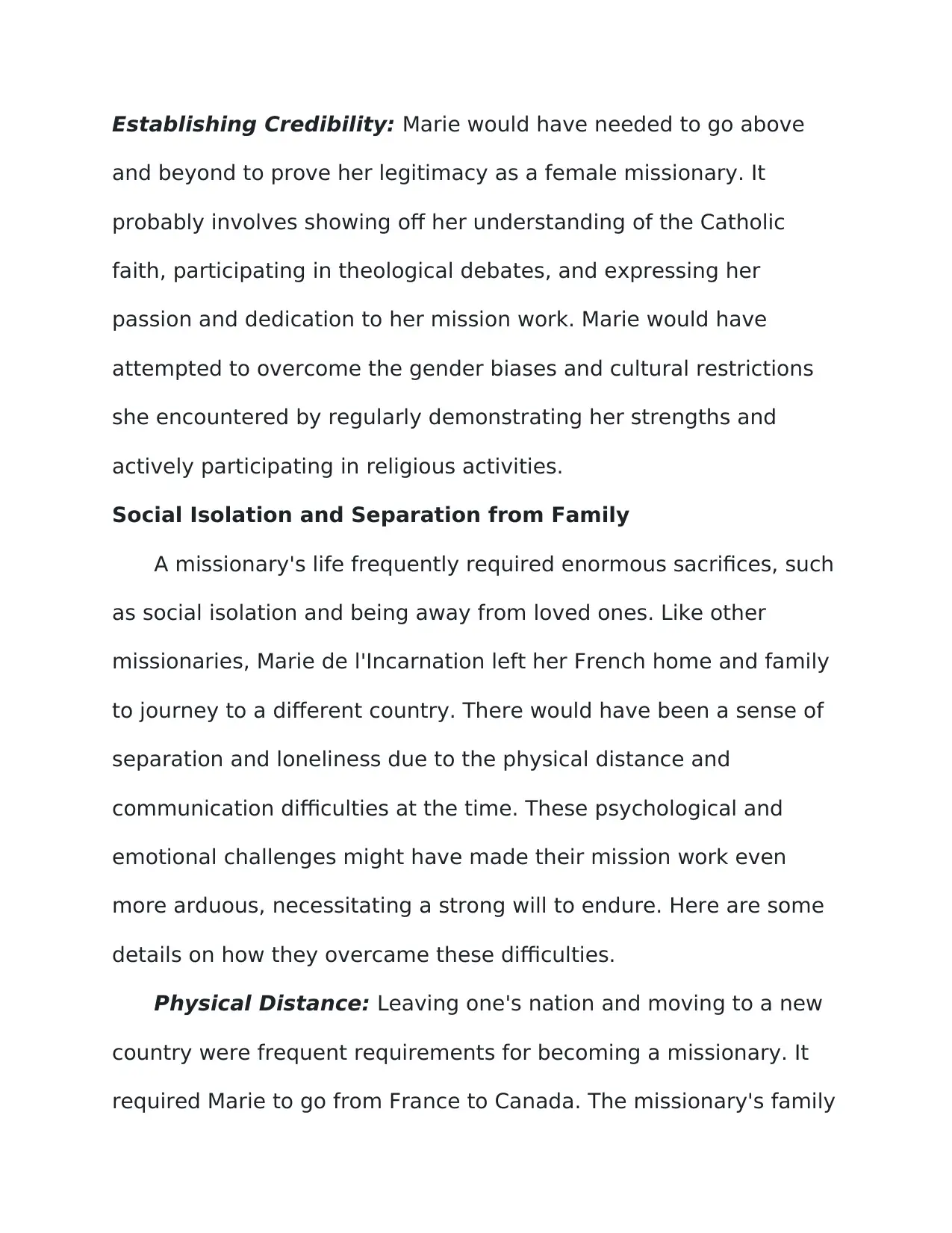
Establishing Credibility: Marie would have needed to go above
and beyond to prove her legitimacy as a female missionary. It
probably involves showing off her understanding of the Catholic
faith, participating in theological debates, and expressing her
passion and dedication to her mission work. Marie would have
attempted to overcome the gender biases and cultural restrictions
she encountered by regularly demonstrating her strengths and
actively participating in religious activities.
Social Isolation and Separation from Family
A missionary's life frequently required enormous sacrifices, such
as social isolation and being away from loved ones. Like other
missionaries, Marie de l'Incarnation left her French home and family
to journey to a different country. There would have been a sense of
separation and loneliness due to the physical distance and
communication difficulties at the time. These psychological and
emotional challenges might have made their mission work even
more arduous, necessitating a strong will to endure. Here are some
details on how they overcame these difficulties.
Physical Distance: Leaving one's nation and moving to a new
country were frequent requirements for becoming a missionary. It
required Marie to go from France to Canada. The missionary's family
and beyond to prove her legitimacy as a female missionary. It
probably involves showing off her understanding of the Catholic
faith, participating in theological debates, and expressing her
passion and dedication to her mission work. Marie would have
attempted to overcome the gender biases and cultural restrictions
she encountered by regularly demonstrating her strengths and
actively participating in religious activities.
Social Isolation and Separation from Family
A missionary's life frequently required enormous sacrifices, such
as social isolation and being away from loved ones. Like other
missionaries, Marie de l'Incarnation left her French home and family
to journey to a different country. There would have been a sense of
separation and loneliness due to the physical distance and
communication difficulties at the time. These psychological and
emotional challenges might have made their mission work even
more arduous, necessitating a strong will to endure. Here are some
details on how they overcame these difficulties.
Physical Distance: Leaving one's nation and moving to a new
country were frequent requirements for becoming a missionary. It
required Marie to go from France to Canada. The missionary's family
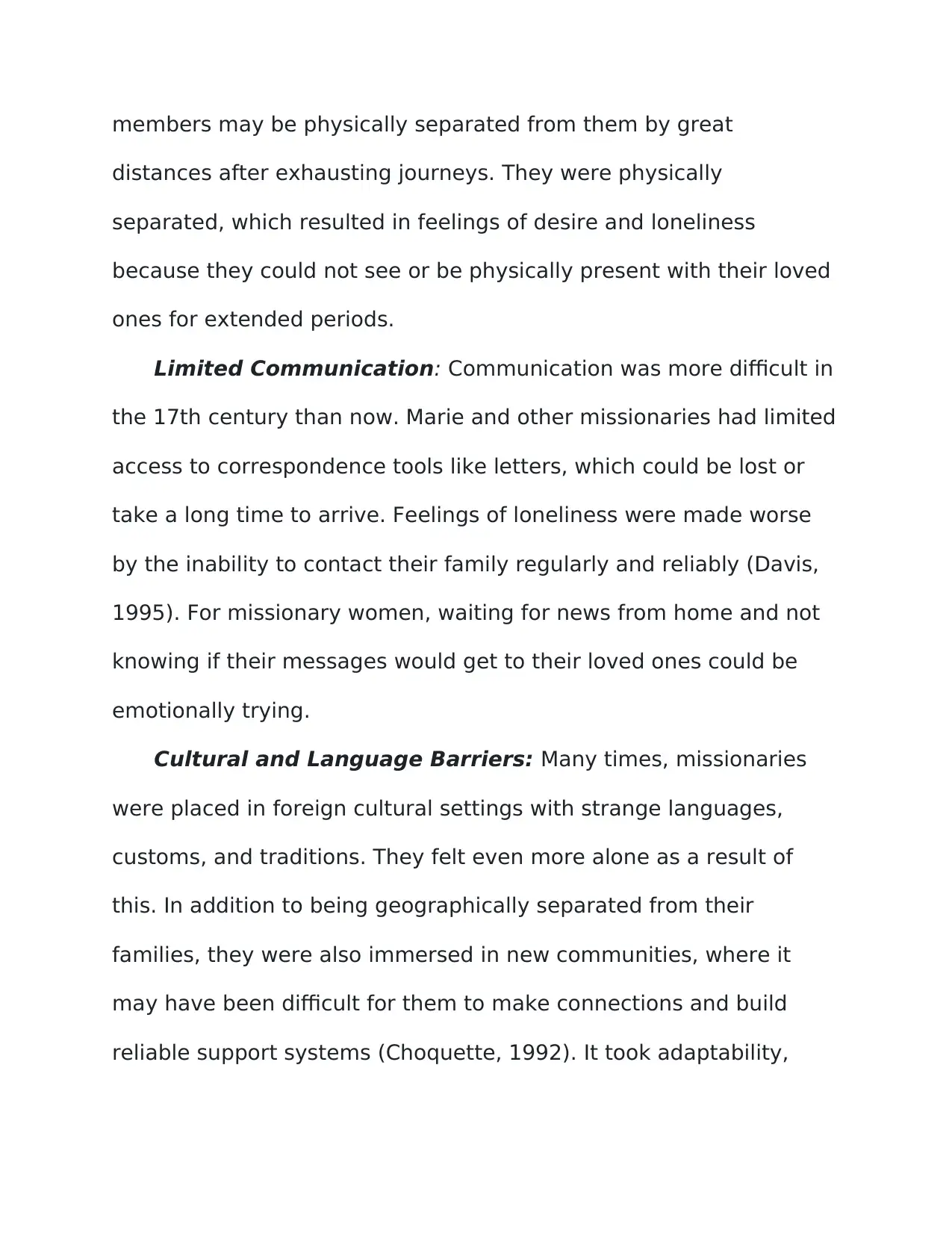
members may be physically separated from them by great
distances after exhausting journeys. They were physically
separated, which resulted in feelings of desire and loneliness
because they could not see or be physically present with their loved
ones for extended periods.
Limited Communication: Communication was more difficult in
the 17th century than now. Marie and other missionaries had limited
access to correspondence tools like letters, which could be lost or
take a long time to arrive. Feelings of loneliness were made worse
by the inability to contact their family regularly and reliably (Davis,
1995). For missionary women, waiting for news from home and not
knowing if their messages would get to their loved ones could be
emotionally trying.
Cultural and Language Barriers: Many times, missionaries
were placed in foreign cultural settings with strange languages,
customs, and traditions. They felt even more alone as a result of
this. In addition to being geographically separated from their
families, they were also immersed in new communities, where it
may have been difficult for them to make connections and build
reliable support systems (Choquette, 1992). It took adaptability,
distances after exhausting journeys. They were physically
separated, which resulted in feelings of desire and loneliness
because they could not see or be physically present with their loved
ones for extended periods.
Limited Communication: Communication was more difficult in
the 17th century than now. Marie and other missionaries had limited
access to correspondence tools like letters, which could be lost or
take a long time to arrive. Feelings of loneliness were made worse
by the inability to contact their family regularly and reliably (Davis,
1995). For missionary women, waiting for news from home and not
knowing if their messages would get to their loved ones could be
emotionally trying.
Cultural and Language Barriers: Many times, missionaries
were placed in foreign cultural settings with strange languages,
customs, and traditions. They felt even more alone as a result of
this. In addition to being geographically separated from their
families, they were also immersed in new communities, where it
may have been difficult for them to make connections and build
reliable support systems (Choquette, 1992). It took adaptability,
⊘ This is a preview!⊘
Do you want full access?
Subscribe today to unlock all pages.

Trusted by 1+ million students worldwide
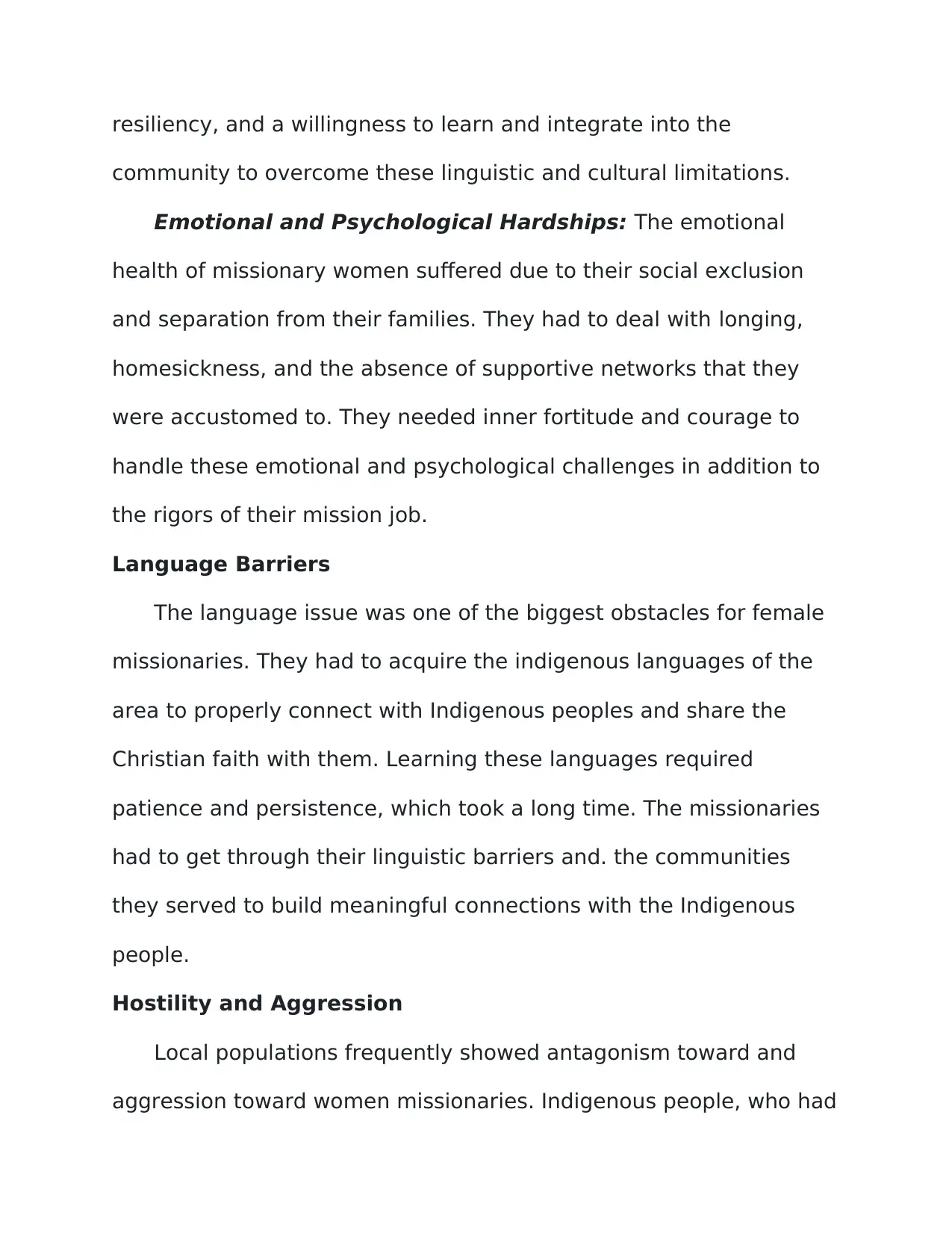
resiliency, and a willingness to learn and integrate into the
community to overcome these linguistic and cultural limitations.
Emotional and Psychological Hardships: The emotional
health of missionary women suffered due to their social exclusion
and separation from their families. They had to deal with longing,
homesickness, and the absence of supportive networks that they
were accustomed to. They needed inner fortitude and courage to
handle these emotional and psychological challenges in addition to
the rigors of their mission job.
Language Barriers
The language issue was one of the biggest obstacles for female
missionaries. They had to acquire the indigenous languages of the
area to properly connect with Indigenous peoples and share the
Christian faith with them. Learning these languages required
patience and persistence, which took a long time. The missionaries
had to get through their linguistic barriers and. the communities
they served to build meaningful connections with the Indigenous
people.
Hostility and Aggression
Local populations frequently showed antagonism toward and
aggression toward women missionaries. Indigenous people, who had
community to overcome these linguistic and cultural limitations.
Emotional and Psychological Hardships: The emotional
health of missionary women suffered due to their social exclusion
and separation from their families. They had to deal with longing,
homesickness, and the absence of supportive networks that they
were accustomed to. They needed inner fortitude and courage to
handle these emotional and psychological challenges in addition to
the rigors of their mission job.
Language Barriers
The language issue was one of the biggest obstacles for female
missionaries. They had to acquire the indigenous languages of the
area to properly connect with Indigenous peoples and share the
Christian faith with them. Learning these languages required
patience and persistence, which took a long time. The missionaries
had to get through their linguistic barriers and. the communities
they served to build meaningful connections with the Indigenous
people.
Hostility and Aggression
Local populations frequently showed antagonism toward and
aggression toward women missionaries. Indigenous people, who had
Paraphrase This Document
Need a fresh take? Get an instant paraphrase of this document with our AI Paraphraser
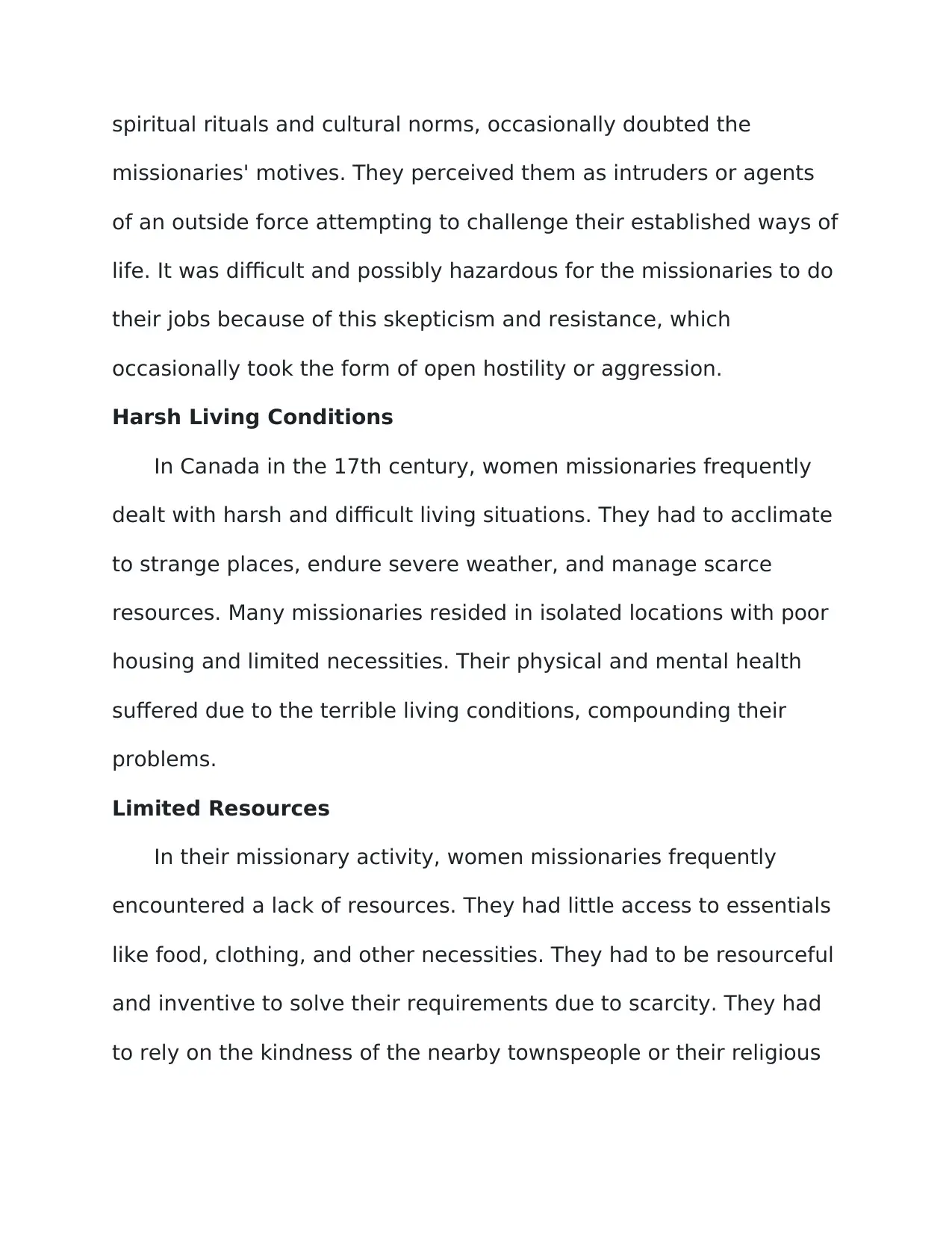
spiritual rituals and cultural norms, occasionally doubted the
missionaries' motives. They perceived them as intruders or agents
of an outside force attempting to challenge their established ways of
life. It was difficult and possibly hazardous for the missionaries to do
their jobs because of this skepticism and resistance, which
occasionally took the form of open hostility or aggression.
Harsh Living Conditions
In Canada in the 17th century, women missionaries frequently
dealt with harsh and difficult living situations. They had to acclimate
to strange places, endure severe weather, and manage scarce
resources. Many missionaries resided in isolated locations with poor
housing and limited necessities. Their physical and mental health
suffered due to the terrible living conditions, compounding their
problems.
Limited Resources
In their missionary activity, women missionaries frequently
encountered a lack of resources. They had little access to essentials
like food, clothing, and other necessities. They had to be resourceful
and inventive to solve their requirements due to scarcity. They had
to rely on the kindness of the nearby townspeople or their religious
missionaries' motives. They perceived them as intruders or agents
of an outside force attempting to challenge their established ways of
life. It was difficult and possibly hazardous for the missionaries to do
their jobs because of this skepticism and resistance, which
occasionally took the form of open hostility or aggression.
Harsh Living Conditions
In Canada in the 17th century, women missionaries frequently
dealt with harsh and difficult living situations. They had to acclimate
to strange places, endure severe weather, and manage scarce
resources. Many missionaries resided in isolated locations with poor
housing and limited necessities. Their physical and mental health
suffered due to the terrible living conditions, compounding their
problems.
Limited Resources
In their missionary activity, women missionaries frequently
encountered a lack of resources. They had little access to essentials
like food, clothing, and other necessities. They had to be resourceful
and inventive to solve their requirements due to scarcity. They had
to rely on the kindness of the nearby townspeople or their religious
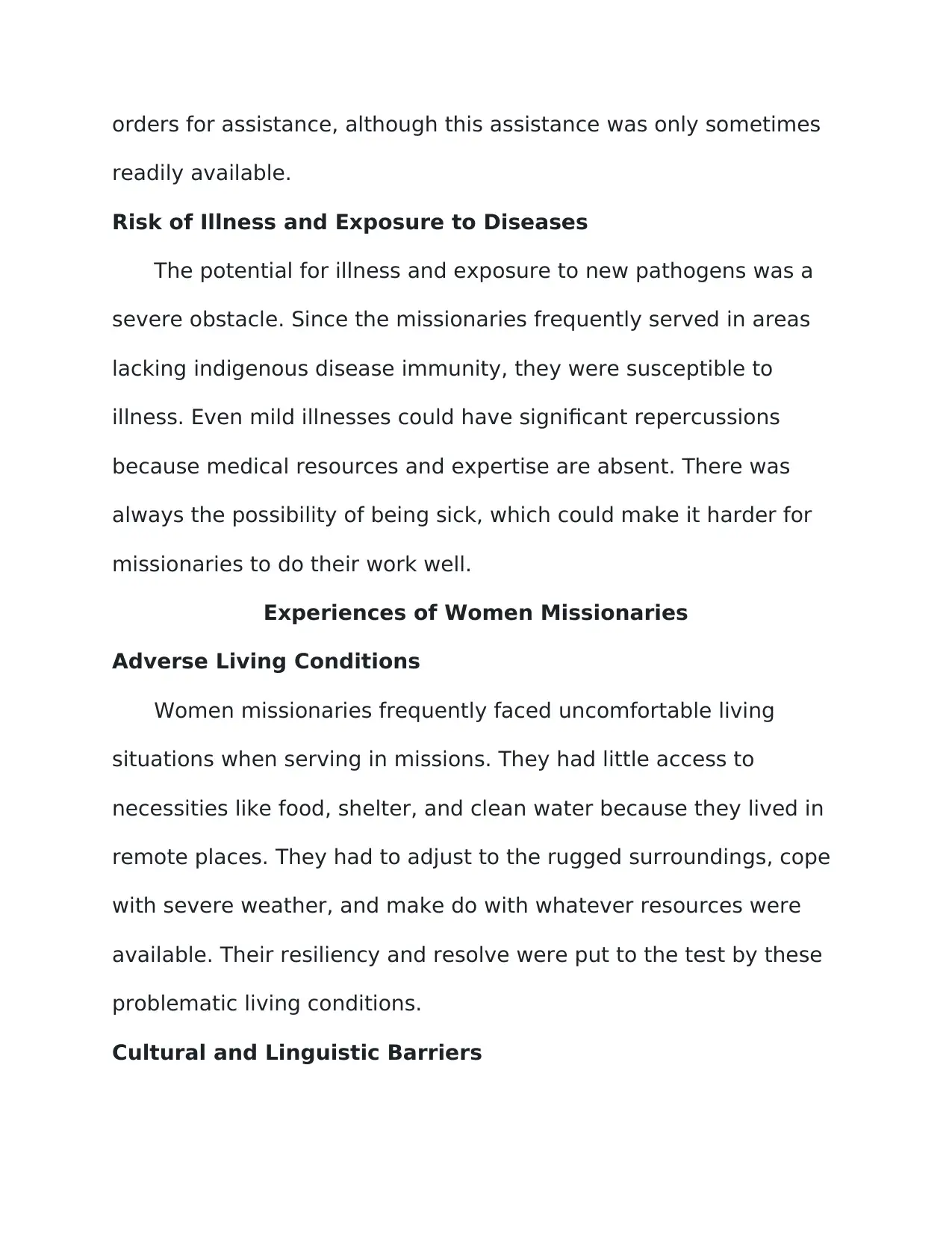
orders for assistance, although this assistance was only sometimes
readily available.
Risk of Illness and Exposure to Diseases
The potential for illness and exposure to new pathogens was a
severe obstacle. Since the missionaries frequently served in areas
lacking indigenous disease immunity, they were susceptible to
illness. Even mild illnesses could have significant repercussions
because medical resources and expertise are absent. There was
always the possibility of being sick, which could make it harder for
missionaries to do their work well.
Experiences of Women Missionaries
Adverse Living Conditions
Women missionaries frequently faced uncomfortable living
situations when serving in missions. They had little access to
necessities like food, shelter, and clean water because they lived in
remote places. They had to adjust to the rugged surroundings, cope
with severe weather, and make do with whatever resources were
available. Their resiliency and resolve were put to the test by these
problematic living conditions.
Cultural and Linguistic Barriers
readily available.
Risk of Illness and Exposure to Diseases
The potential for illness and exposure to new pathogens was a
severe obstacle. Since the missionaries frequently served in areas
lacking indigenous disease immunity, they were susceptible to
illness. Even mild illnesses could have significant repercussions
because medical resources and expertise are absent. There was
always the possibility of being sick, which could make it harder for
missionaries to do their work well.
Experiences of Women Missionaries
Adverse Living Conditions
Women missionaries frequently faced uncomfortable living
situations when serving in missions. They had little access to
necessities like food, shelter, and clean water because they lived in
remote places. They had to adjust to the rugged surroundings, cope
with severe weather, and make do with whatever resources were
available. Their resiliency and resolve were put to the test by these
problematic living conditions.
Cultural and Linguistic Barriers
⊘ This is a preview!⊘
Do you want full access?
Subscribe today to unlock all pages.

Trusted by 1+ million students worldwide
1 out of 24
Your All-in-One AI-Powered Toolkit for Academic Success.
+13062052269
info@desklib.com
Available 24*7 on WhatsApp / Email
![[object Object]](/_next/static/media/star-bottom.7253800d.svg)
Unlock your academic potential
Copyright © 2020–2025 A2Z Services. All Rights Reserved. Developed and managed by ZUCOL.